How to spray gooseberries in spring. How to get rid of powdery mildew on gooseberries
Powdery mildew is one of the most common. It is also called a sphere library. The cause of the disease is a fungus. In spring, its spores gradually disperse and infect new shrubs. As a result, all parts of the plant will be affected. First, a white coating appears on the berries, leaves, and stems. Then it gradually turns brownish and at the same time becomes denser. With this disease, shoots, leaves and berries are deformed. As a result, within a couple of years the entire plant will dry out and die.

To prevent the appearance powdery mildew on gooseberries, it is recommended to choose plant varieties that are resistant to the fungus. In addition, experts recommend the following techniques:
- 1. If the bush is already sick, then a solution based on zinc, manganese sulfate, copper, and boron must be added to the area near its roots. This is good prevention for the soil.
- 2. In spring, it is necessary to additionally treat the bushes with a solution of copper sulfate. You will need 300 g of this product per 10 liters of liquid. The procedure should be carried out during the formation of buds and flowering of the bushes. The spraying procedure should be repeated after 1.5-2 weeks, and the last treatment should not be later than 2 weeks before harvest.
- 3. Mix regular laundry soap with soda ash. Take 50 g of both components. Then dissolve in 10 liters of liquid. Treatment is supposed to be carried out every 10 days.
- 4. Use coal or wood ash. For 10 liters of boiling water you will need approximately 3 kg of product. Shrubs need to be treated once every 10 days. Spraying is necessary.
- 5. One more thing useful remedy, which will help cure powdery mildew on the site is bleach. You only need 2 large spoons per 10 liters of water.
- 6. Mustard. For treatment, gooseberries are used in powder form. You need to dissolve a couple of spoons of the product in 10 liters of liquid. Then heat the product and boil for 30 minutes. After this, filter the solution. Afterwards, they can be used to treat all plants.
- 7. Another remedy is iron sulfate. For 10 liters of liquid, 300 g of product is required. Before starting treatment, it is necessary to cut off all parts of the bushes that have already become infected. It is also recommended to treat the soil on which gooseberries grow with a similar composition.
You can also use beneficial bacteria. To do this, you will need 3 portions of water per 1 portion of mullein or rotted hay. Then the solution should be infused for three days. After this, it must be made weakly concentrated, that is, 1 part of the resulting composition must be dissolved in 3 parts of ordinary clean water. As soon as bacteria from such a product enter the bushes, they begin to attack fungal crops and eat them. You can also use Fitosporin.
All treatments should be carried out three times: before flowering, during the flowering period, and also after the leaves fall.
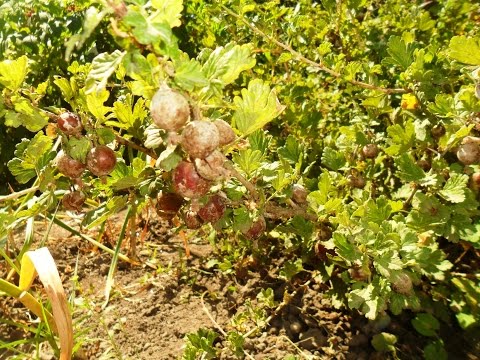
Other diseases
Another common disease of gooseberries is anthracnose. The main symptom of this disease is that the plant develops brown spots on the foliage. At the next stage in the development of this disease, the leaf begins to curl and become deformed. As for the berries, they simply fall off or change their taste qualities– become very sour.

Basic methods of combating anthracnose:
- 1. Remove affected leaves and branches in spring and autumn.
- 2. Dig up the soil around the bush.
- 3. Treat with Hom. The solution is prepared as follows - 40 g of the drug is required per 10 liters of liquid.
- 4. Use colloidal sulfur. It is used to spray the plant. Carry out the procedure during the flowering period.
- 5. Bordeaux mixture. To prepare such a composition, you need to dissolve 40 g of vitriol in 10 liters of liquid. Treat shrubs with the solution 2-3 times. Sometimes you can carry out the procedure a fourth time - this depends on the severity of the gooseberry disease. It is necessary to begin procedures with Bordeaux mixture before flowering begins. The period between sessions should be 2 weeks. Sometimes it is allowed to increase the concentration of the solution - this applies to more severe cases of the disease.
Another disease that often appears in gooseberries is goblet rust. It is characterized by the fact that back side yellow growths appear on the leaves. This rash then spreads to the berries and stem. After this, the new growths begin to resemble a felt coating. It has been noticed that this disease appears in places where sedge (this is a weed plant) is common.
Treatment of such rust is carried out as follows:
- be sure to dig up the soil;
- always pull out the sedge and prevent its thickets from appearing;
- use fertilizers that contain phosphorus and potassium;
- use Phytosporin, Bordeaux mixture or fungicidal agents for spraying plants.
Mycoplasmosis is another disease that develops on gooseberries. This disease is also called terry. Its cause is a mite that affects the buds on the bush. As a result, he is reborn. Its characteristic aroma disappears, the leaves turn from five-lobed to three-lobed. The brushes become thinner, and the inflorescences acquire purple shade. To treat such a disease, certain measures must be taken:
- 1. Remove ticks and aphids in a timely manner, using a variety of preparations.
- 2. Use complex fertilizers that contain molybdenum, manganese, and boron.
- 3. Do not use fertilizers that contain large amounts of nitrogen.
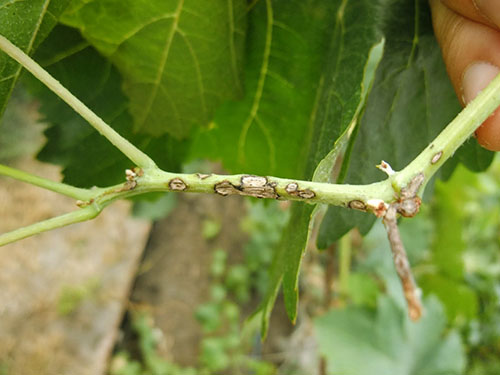
Another common disease of gooseberries is septoria. In the early stages, it is characterized by the appearance of small spots of a brownish tint, which gradually become white in the center and remain dark at the edges. In more advanced stages, the berries are affected and the foliage begins to fall off. To get rid of this problem, it is necessary to carry out a set of measures:
- remove affected branches;
- collect fallen leaves and burn them;
- dig up the soil;
- use Nitrofen;
- use copper sulfate.
But this is a rather rare occurrence. Potatoes suffer from this disease fruit trees, currant bushes, raspberries, strawberries. Many gardeners confuse powdery mildew with scab on gooseberries. If such suspicions arise, it is recommended to use copper sulfate, Bordeaux mixture or Fitosporin.
Physiological diseases
Not only fungal and bacterial diseases are dangerous for gooseberries. These shrubs are also susceptible to physiological diseases. They usually develop if the plant is not properly cared for. A common cause is unsuitable soil. Typically, such problems are associated with a lack of certain nutritional compounds.

The most popular physiological diseases:
- 1. A lack of nitrogen provokes a slowdown in plant growth. The foliage begins to turn yellow and the fruits fall off. In such cases, fertilizing with nitrogen-containing products is necessary. It is imperative to strictly follow the instructions for such formulations, especially with regard to dosage. Nitrogen is usually required in large quantities during vegetative development.
- 2. Lack of phosphorus leads to the fact that spots of yellowish-green and dark green shades begin to appear on old foliage. The shoots become thinner and the buds do not have time to fully develop. The plant's resistance to cold temperatures decreases.
- 3. Lack of potassium leads to poor absorption of phosphorus and nitrogen. Due to such problems, the leaves begin to turn pale. Stripes of a brownish or purple hue appear on them. Gradually the foliage dies off. The buds grow already defective, so that in the future the fruits and new shoots are underdeveloped. Gooseberry resistance to frost decreases.
- 4. A lack of magnesium leads to the fact that various diseases begin to appear in gooseberries. The viability of the culture is sharply deteriorating. The root system also weakens.
- 5. Lack of calcium leads to deterioration of the root system. But an excess of this substance has the same effect. The roots begin to resemble stumps. To combat this problem, watering is reduced and peatlands are drained.
- 6. Lack of iron causes the ends of the shoots and foliage to begin to turn yellow. This occurs due to systematic waterlogging of the soil and lack of organic matter. Drought also contributes to iron deficiency. To prevent this, it is necessary to add humus to the soil. It is also allowed to add iron sulfate. You will need 150 g of product per 10 liters of irrigation liquid.
The lack of all these substances can be compensated by applying suitable fertilizers. Caring for the plant must be correct. This applies to loosening the soil, removing weeds, watering, and other procedures.
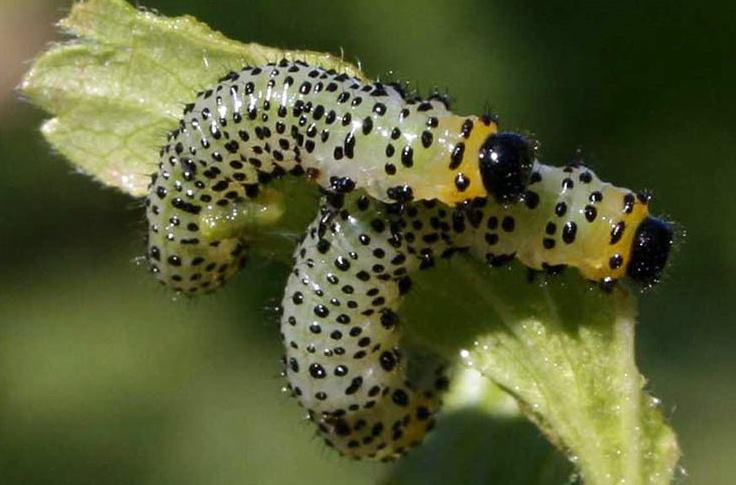
Gooseberry moth caterpillars are also dangerous. They grow up to 4 cm in length. To destroy them, the same drugs are used as against the sawfly. The same applies to the gooseberry moth caterpillar. It is necessary to remove the nests by hand, and if it is not possible to do this, then simply spray the bush with insecticidal preparations.
There are other pests that are dangerous to gooseberries. An example is the currant glass. This butterfly is capable of laying up to 60 eggs. Caterpillars eat the cores of the shoots and make passages into them. Because of this, the branches wither and dry out. Insecticidal preparations are used to combat glassware. It is necessary to immediately cut off the affected shoots, and treat the cut areas with garden varnish. The same applies to currant gall midge, which also affects gooseberries.

Another problem is currant bud mites. They penetrate the buds and suck the juice from the leaves. Acaricidal drugs are used against ticks. A solution of colloidal sulfur is also suitable (100 g of product is required per 10 liters of water). All excessively large buds must be cut off.
To prevent the appearance of various diseases or pest attacks on gooseberries, it is necessary to carry out preventive measures:
- 1. Avoid thickening the plant. Be sure to trim dried and damaged branches.
- 2. Remove and collect fallen leaves. Then burn them.
- 3. It is recommended to plant plants next to the gooseberries that can repel various pests. Chrysanthemums, dill, garlic, marigolds are suitable.
- 4. In early spring, it is recommended to water the bushes with boiling water once to destroy fungal spores.
- 5. In the spring, spray the bushes with zircon solution to strengthen their immunity.
Proper feeding is also very important, since all plants need additional nutrition. All useful material bushes can be obtained from mineral or organic fertilizers. This will help increase the gooseberry's resistance to various diseases and pests. More nitrogen is needed in spring. You will need 25 g of ammonium nitrate for each square meter. Instead of such a product, it is allowed to use urea (30 g each).
Fertilizers that contain a large number of phosphorus and potassium, it is recommended to add to the soil only a year after planting the crop. Sometimes you can wait several years - it depends on the fertility and composition of the soil. Half a bucket of rotted manure is required per square meter.

You can use 100 g of ash, 45 g of superphosphate, 15 g of potassium chloride. Such fertilizers should be applied in the fall. It is enough just to scatter them around the bushes at a distance of no more than a couple of meters. It is this distance that the root system grows and then begins to go deeper.
Gooseberry bushes are often attacked by various pests, and also suffer from fungal and bacterial diseases. To prevent this, special preventive measures are required.
(c) Katerina Shlykova
Powdery mildew- one of the most dangerous diseases for gooseberries. It can destroy the entire crop, and in a few years the plant itself. In addition, powdery mildew is a common disease, the distribution area of which is very wide. The spores of this disease develop especially actively in warm and humid weather.
If late May - early June examine the gooseberry bushes, you can find leaves, young shoots and already established berries this is such a loose (mealy) coating white:
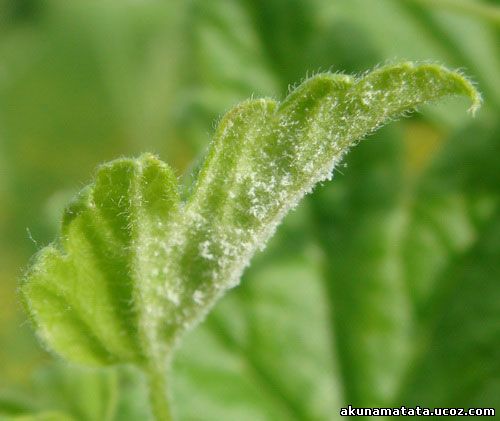

Apparently due to appearance and the name of the disease - .
In the future this the plaque becomes denser, darkens, turns brown, crust-like:

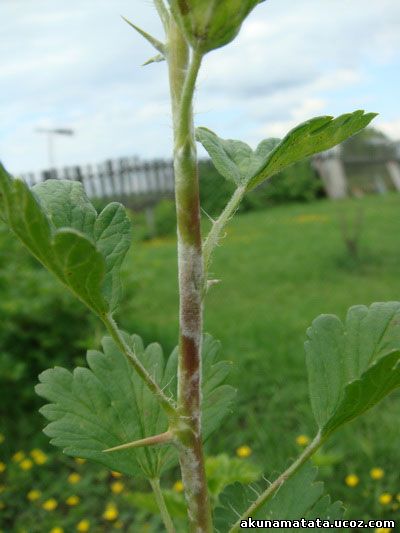
Affected shoots become twisted and eventually dry out. Affected leaves curl, become brittle, and stop growing. The affected berries do not have time to ripen; they simply crack and fall off the bush green. The result of such a disease is the lack of harvest and young growth, and within a few years the death of the entire plant.
Powdery mildew (or spheroteca) is a fungal disease that begins to spread in the spring with the onset of warm weather through spores. By the way, this disease comes from America, so it is often called “American powdery mildew” in the literature. Well, again, trouble is upon us from the American continent. Colorado beetles are not enough for them. Actually, as has already been said, this is a really bad disease that you should not ignore. But despite all its seriousness, powdery mildew is quite easy to combat.
Two directions of action can be distinguished here - agrotechnical and chemical, which give good results in aggregate.
For those who in no way accept the use of chemicals on their site, agrotechnical methods (including folk recipes) may be quite sufficient. But if the disease is still too rampant or the gooseberry plantations are extensive, then, perhaps, you should not give up chemicals. Moreover, literally one spraying with them is enough, while folk recipes you will have to resort not two or three times per season, but more, especially if warm and humid weather contributes to the spread of powdery mildew.
PREVENTION of powdery mildew:
1. Bush pruning gooseberries autumn or early spring promotes good development of the bush and helps resist various diseases, incl. and powdery mildew. During pruning, be sure to remove branches affected by the disease, and then it is better to burn them or take them away from the site and bury them deeper.
2. During the entire growing season (i.e. spring and summer) detected disease-infected shoots and berries if possible delete. It is believed that the disease spores overwinter on affected shoots, and sometimes on fallen leaves. Therefore, in early spring, last year’s foliage should be removed from under the bushes.
3. In early spring, when the snow had just melted around the bushes and the threat of severe frost had passed, but strictly BEFORE kidney swelling, good pour hot (+90) water over the gooseberry bushes. In such water you can dissolve potassium permanganate until Pink colour or soda (1-2 tablespoons per 10 liters of water). Such a “hot shower” is good as a preventive measure against many fungal diseases, and black currant They say it also helps against spider mites.
4. Use only as fertilizers potassium(which includes, for example, ash) and phosphorus. They contribute to the resistance of gooseberries to powdery mildew disease. But it is better to refrain from nitrogen fertilizers. Nitrogen can cause the shoots to not have time to ripen and, as a result, to be more affected by powdery mildew.
It is useful to use these methods of prevention in combination.
RECIPES FOR TREATING powdery mildew with chemistry and folk remedies:
1. In early spring BEFORE the buds swell For gooseberries, spray the bushes and the litter around them (last year's grass, leaves) with a 1% solution of copper sulfate (100 grams of copper sulfate per 10 liters of water).
2. In magazines and literature it is recommended to use the chemical drug "Topaz" (according to the instructions). Spray with this solution twice if necessary - BEFORE flowering and immediately AFTER flowering. You can get by with just one spray - immediately AFTER flowering. I have tried this drug in practice and can confirm its effectiveness.
3. An excellent drug for combating powdery mildew is "HOM". This is a kind of Bordeaux mixture substitute. Bushes sprayed HOM solution (0.4%, i.e. 40 g HOM per 10 liters of water) BEFORE the gooseberries bloom. Despite the fact that "HOM" is a copper-containing drug, it can be used in combination with drugs against pests. That is, we take 40 grams of HOM and dilute it in small quantity water. Then we take ampoules of “Fufanon” or “Decis” (calculation according to the instructions included with the drugs) and also dilute them in a small amount of water. Then mix these two solutions together and bring to 10 liters of water. Spray BEFORE flowering.
4.
150 g of laundry soap + 20 g of copper sulfate per 10 liters of water.
Laundry soap is grated on a grater with large holes. Copper sulfate is first dissolved separately in hot water, and then pour in a thin stream, stirring constantly, into soap solution room temperature. The resulting soap-copper emulsion should be bluish in color, uniform in consistency, without flakes falling out. Spray IMMEDIATELY AFTER FLOWERING, or in the worst case, immediately after setting the berries.
5.
Here are a number of other drugs recommended in various literary sources (though I have not tried them): “Vectra”, “Skor”, “Cumulus”, “Abiga-Peak”, colloidal sulfur.
"Tiovit Jet" (20-30 g per 10 liters of water) is characterized, like other sulfur preparations, by a protective and infection-eradicating effect in the initial stages of development of powdery mildew. It is also used on currants.
6. 50 g of soda (2 tablespoons) + 50 g of laundry soap per 10 liters of water. The soap is grated on a grater with large holes. All this is thoroughly dissolved in water. I do not spray the bushes with this solution, but water it directly from a watering can through a strainer attachment, and also water the ground around the bushes. Good prevention. This procedure must be done BEFORE flowering as soon as the leaves began to bloom, and IMMEDIATELY AFTER FLOWERING. If necessary, you can repeat the procedure 2 more times with an interval of 7-10 days.
7. The daily infusion of ash is 3 kg of ash per 10 liters of water. The ash is poured with boiling water and left for a day, then strain the resulting infusion and spray the bushes with it. before and after flowering. This procedure is usually repeated 2-3 times with an interval of 7-10 days. One bush consumes 2.5-3 liters of liquid. I don’t really like this method, because I don’t like messing around with ash this way. And besides, for me, ash is primarily important as a fertilizer for cabbage, strawberries, onions and other crops. Therefore, I do not use it to treat gooseberry powdery mildew. Note - one liter jar holds 500 grams of ash.
8. And another way to combat powdery mildew. Take 200 grams (1 glass) of urine and dilute it in 5 liters of water. The resulting solution is immediately sprayed onto the bushes. This spraying is carried out immediately AFTER the gooseberries bloom. The procedure is repeated 3-4 times per season with an interval of 7-10 days. This recipe was shared by one of the readers of the Homestead magazine. I tried it, it helps.
Of course, I don’t use all the treatment recipes at once in one season. I choose the one that is most convenient for me this moment recipe. For example, this summer I resorted to a solution of soda and laundry soap (point 6). I watered my bushes before flowering and immediately after.
So I think that I should choose one of the recipes and carry out two sprayings: the first before flowering, and the second immediately after
, and this will be quite enough to defeat powdery mildew.
It must be said that among the gooseberries There are varieties that are resistant to powdery mildew.
And if you don’t want to get involved with this disease at all and waste your precious time on all sorts of spraying, then it’s better to choose just such varieties and breed them on your site.
Here are some varieties that are resistant to powdery mildew:
"Kolobok" (tested in practice, a bush of this variety grows next to the local gooseberry, which every year is covered with a white coating, and "Kolobok" is fine without spraying)
"Ural grapes" (the variety's resistance to powdery mildew was also tested personal experience)
"Kuibyshevsky"
"Grushenka"
"Finnish"
"Senator"
"Harlequin"
"African"
"Houghton"
"Masheka"
"Anniversary"
In general, it has been noticed that thornless gooseberry varieties are almost not susceptible to powdery mildew. So when choosing a variety, you should pay attention to the presence or absence of thorns.
But there is varieties that are susceptible to powdery mildew:
"Lefort seedling" (I get sick every year, I always have to spray)
"Date fruit"
"Triumphal"
"Golden Light"
"Prune"
"Russian"
Another useful rule - when buying seedlings you need to be careful and do not take those that raise doubts, are covered with an incomprehensible coating and look dubious.
In conclusion, I would like to say that many plants suffer from powdery mildew - trees, flowers, vegetables. But, apparently, for each type of plant there is a separate fungus-spore of powdery mildew, which spreads only on it and nowhere else. In other words, if your gooseberry gets powdery mildew, then, for example, cucumbers planted nearby will not get powdery mildew from the gooseberries. At least this is what happens in my garden. Gooseberries have their own powdery mildew, which is not transmitted to other crops, cucumbers have their own, flowers have their own, apple trees also have their own, etc.
Have a rich harvest and may your gooseberries never become covered with a white coating!
Always with you,
Katerina Shlykova (amateur gardener since 2003)
Quoting and partial copying articles and stories, possibly indicating the source in the form active link to the corresponding page of the site.
It is very easy to recognize a serious disease of a cultivated plant; you just need to pay attention to the bush and berries in time.
The fruits are covered with a white coating or a light white-yellow film, which dries out and turns into thicker formations that affect the entire surface. Powdery mildew can also spread to leaves, but more often it is found on currant bushes.
Gooseberry fruits under the influence dangerous disease change in shape, become smaller, develop poorly and dry out, and the leaves curl, dry out and lead the plant to death.
Due to the rapid development of the disease, it must be combated very actively, otherwise the lesions can spread not only to one bush and ruin its harvest, but also spread to nearby plants, thereby depriving you of the entire harvest.
Powdery mildew can attack gooseberries from other plants, for example, from currants, strawberries and others, but it often happens that the causative agent of the disease simply overwinters in the soil and in a favorable period moves onto the plants.
How to protect plants from powdery mildew
There are many preventive methods, which we have already discussed in a number of articles where the topic of powdery mildew on shrubs and trees was touched upon (for example, apple trees), vegetable crops and even flowers. But the main problem is that many summer residents are in no hurry to carry out prevention, but are ready to poison plants and soil already at the moment when diseases or pests are in the active phase.
But problems can be prevented, and this can be done better in the following ways:
- Try to keep the area as clean as possible from weeds, remove growth and mowed plants in a timely manner, and avoid contamination and thickening;
- Choose for planting only healthy and strong plants that are necessarily adapted to the planting region;
- Pruning and shaping plants, removing removed branches and plants from the garden or even the entire dacha, and burning them outside the territory;
- Try to clean the area after leaf fall, clean the soil (cultural mulching and insulation are not considered here).
How to deal with powdery mildew on gooseberries
It is far from certain that preventive measures will help completely resolve the issue. Or it may simply happen that the disease comes from the other side of the garden bed, which you have not cultivated, or even from neighbors who do not garden at all. In general, the problem is real even with the closest attention, and therefore we need safe methods to combat it.
Copper sulfate for powdery mildew
A solution of copper sulfate, namely a mixture of 80 g per bucket of water, is recommended to be used for treating plants and soil in early spring, even before the buds open. It is advisable to carry out the treatment from a sprayer, very carefully.
Treating gooseberries with soap and soda
You can also spray after the gooseberries bloom. To do this, dissolve 50-60 g of soda ash in a bucket of water and add a little grated laundry soap to make the solution thicker and stick well. Here you can already use a broom for processing.
Potassium permanganate solution for powdery mildew
Pre-treatment of gooseberries or in the first stages of the disease can be done using a very weak solution of potassium permanganate, up to 1.5 g per bucket of water.
Treatment of gooseberries with mullein solution
A specially prepared mullein solution infused for 3-4 days will also help cope with the disease. You just need to take fresh mullein and dilute it clean water, 1:3, then insist and dilute again, also 1:3. Spray the plants not very generously, but thoroughly, preferably with a simple broom, every week.
Treatment of gooseberries with ash solution
Spraying with a solution of wood ash is considered very effective, and most importantly, safe for plants and humans.
To prepare a remedy for powdery mildew, you need to a whole ritual, but it's quite simple. Immediately 1 kg of clean and, preferably, sifted ash is dissolved in a bucket of heated water. The resulting solution is stirred once a day and infused for 4-7 days.
On the last day, do not stir the solution, but let it settle well, after which the liquid is very carefully poured into another container, without sediment. You can add a little grated laundry soap here, dissolve it well and treat the plants through a sprayer.
Spraying should be carried out in the evening, in calm weather, carefully treating all leaves and shoots. The remaining mixture can be supplemented with water and watered over the plants to kill everything unnecessary in the soil.
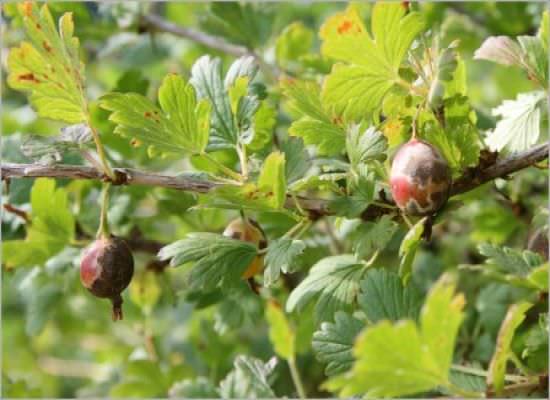 Rating 3.33 (3 Votes)
Rating 3.33 (3 Votes)
Attention, TODAY only!
